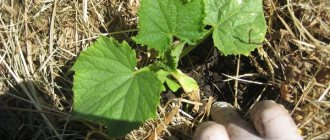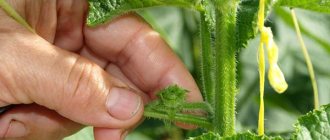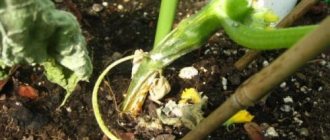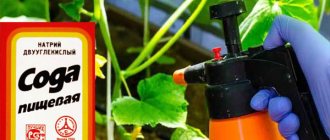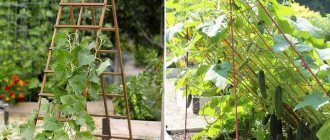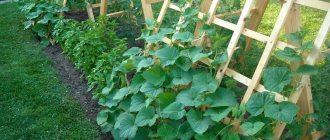Fruiting of cucumbers usually ends in August. Is it possible to extend this period? First of all, do not allow the formation of yellow seeds - this is a signal for the plant to complete fruiting. Well, provide the cucumbers with careful care: cover them from rain and cold, water them with warm water, feed them and spray them against diseases. How else to prolong the fruiting of cucumbers, read our article.
Photo pixabay/Alexey_Hulsov: There are many ways to increase the harvest season.
Method No. 1 on how to prolong the fruiting of cucumbers in a greenhouse by adjusting the temperature regime
In August, temperatures can be very high during the day and the nights are already cold. Cucumbers stop growing at temperatures below +15°C. Many gardeners have a stove in the greenhouse; they heat it in the evening so that the plants have enough heat throughout the night. If there is no stove, you can leave smoldering firewood in an iron container - the effect will be the same.
Temperature changes cause condensation to accumulate, and this is a provoking factor for disease. Therefore, be sure to ventilate greenhouses during the day to reduce evaporation at night.
Additional care rules
In addition to the above, a number of actions will help increase the yield and extend the fruiting period:
- Harvest regularly. Overripe cucumbers take away the vitality of the plant.
- Mulch the cucumber beds with a layer of peat, sawdust or humus to protect the roots from freezing at night and from overheating in the daytime heat.
- Regularly inspect the plants for yellow leaves; they should be removed, as well as those located below the fruiting level.
- When cultivating bee-pollinated varieties, it is necessary to attract pollinating insects to the site. To do this, plants are sprayed with a solution of water and honey (1 tsp per 1 liter of water). You can also attract them if you plant flowers with late flowering periods (chrysanthemums, oregano, phacelia) next to the beds.
- Since night snaps and cold rains are likely in August and early autumn, plants are covered with a protective cover at night or before precipitation.
Method number 4: proper watering of cucumbers
Watering in August is significantly reduced: if the air temperature drops below +18...+20°C, the crop is watered at the rate of 2 liters per plant; at 15°C, the bushes require no more than 0.5 liters of water per watering. To reduce the formation of condensation, water cucumbers only in the morning. Warm water is used, heating it to +22…+24 degrees.
| Remember! Cucumbers need moisture and warmth. Cold water promotes the appearance of hook-shaped greens and the fruits become bitter. |
The following recommendations on how to prolong the harvest of cucumbers will also be useful:
- To increase humidity in greenhouses and greenhouses, place containers with water.
- In hot weather, you can water the paths between the beds.
- Constantly cover the roots exposed after watering with soil.
What to feed to prolong fruiting
Fertilizing helps to extend the growing season and fruiting period of cucumbers:
- spraying the leaf with a solution of urea (10-12 g per 10 liters of water) - improves photosynthesis, stimulates the growth process, the formation of new shoots;
- watering the crop with ash solution (1 tbsp per 10 l), in rainy weather you can simply sprinkle fertilizer in the rows;
- spraying with potassium magnesia - dilute 15 grams of the drug in a bucket of water.
Long-term fruiting is helped by fertilizing with folk remedies: herbal infusion, whey or baking soda solution, onion peel infusion.
Method number 5: proper feeding of cucumbers
It is necessary to feed cucumbers to prolong fruiting:
- Feeding with ash. To strengthen the root system and replenish potassium reserves in the soil, be sure to feed cucumbers with an infusion of ash in the last summer month. To do this, pour 0.5 liters of dry matter into a bucket of boiling water, leave for three days, and then water at the root.
- Feeding with superphosphate. Ash can be replaced by fertilizing with phosphorus-containing fertilizers, for example, superphosphate. In addition to phosphorus, it contains microelements needed by plants - calcium and magnesium: cucumbers absorb it well. It is better to dilute it in water at the rate of 50 g of fertilizer per 1 sq.m of bed.
- Fertilizing with urea. To rejuvenate leaves and stems, foliar fertilizing with urea is carried out (1 tablespoon per bucket of water). This fertilizing can also be applied at the roots, but due to the cool nights in August, the roots absorb nutrients less well, and foliar fertilizing is more effective.
- Feeding with fresh manure. When fresh manure is available, it is also used for fertilizing. A concentrate is first prepared from fresh manure: 1 part of manure is diluted in 3 parts of water. Leave for about a week, then dilute the fertilizer 10 times and water the cucumbers at the root.
| Important! The bed must be constantly mulched. |
Photo pixabay/MetsikGarden: Apply foliar feeding.
Organic fertilizers
Organic fertilizers include various infusions of herbs, bird droppings or manure, as well as infusions of wood ash. They can be alternated with mineral fertilizers, but each gardener decides for himself what to use: mineral water, organic matter, or a combination of both.
In the flowering phase
Before flowering, cucumbers are fed with fermented infusion from the herb. It is best to use young crushed twigs and leaves of nettle and dandelion. They fill the container to 2/3 of the volume, add water and cover with a lid. In warm weather, the infusion begins to ferment and is ready for use in 7–10 days . The readiness of the infusion is indicated by strong foam on the surface and a very unpleasant odor.
To speed up the fermentation process and increase nutritional value, you can add EO preparations, yeast, stale bread, a glass of manure or humus.
The finished infusion is diluted an additional 5 times and then 0.5–1 liter of solution is poured onto damp soil under each cucumber bush.
If you add EM preparations to the herbal infusion, the finished infusion will smell like mash or kvass.
It is better to make a herbal infusion from nettle with the addition of EM preparations
An infusion of ash is also an excellent supplement: 1 glass of ash is poured into 10 liters of water and left for 24 hours.
Method No. 6: protecting cucumbers from diseases to extend the harvest season
Closer to autumn, cucumbers may be affected by powdery mildew. The occurrence of the disease is provoked by increased importance and sudden changes in temperature, which are not uncommon in August. For prevention, use fumigation of the greenhouse with a tobacco stick, reduce watering and regularly ventilate the greenhouse even on cold cloudy days. If the disease appears, then all diseased leaves are torn off and destroyed. Be sure to feed the bushes with an infusion of ash, which contains the potassium that cucumbers need. It strengthens their immunity and helps resist fungal infections.
Throughout the season, milk and iodine are used as a prophylactic agent. The medicinal cocktail is prepared as follows: 9 parts water – 1 part milk. At the end, add 3 drops of iodine to each liter of the finished mixture. Spraying is carried out once every ten days.
Powdery mildew can be sprayed with a solution of sour milk. For a bucket of water you will need 1 liter of sour milk.
Onion peels for cucumber diseases
A solution based on soda and laundry soap is also considered to be effective in helping to prevent infections; an infusion of onion peels or tobacco dust, to which soap is also added. Onion peels are a good way to prolong the fruiting of cucumbers in open ground and greenhouses:
- Fill 1/4 of a ten-liter bucket with onion peels. Heat water to 90°C, fill the bucket to the top and close the lid.
- Place the bucket in the shade for a day and try to stir more often. After a day, squeeze out the husks and place them in the holes.
- Dilute the remaining infusion with warm water (1:5) and pour over the cucumbers. Carry out this procedure once a week.
If it is not possible to carry out protection using “home recipes”, use ready-made biological protection products that are commercially available. They are prepared according to the instructions.
Photo pixabay/Alexei_other: Protect plants from diseases.
Time-tested varieties
The seed market offers F1 varieties and hybrids. Their difference lies in the characteristics of inheritance of traits. The offspring that grows from seeds taken from varietal plants completely replicates their qualities. But in F1 hybrids, in the next generation (F2), the characteristics begin to split (the characteristics of one of the original parental varieties begin to prevail), so seeds are not collected from such plants. F1 hybrids are usually more resistant to pests and diseases, and often have higher yields. That is why the overwhelming number of cucumber seeds that are now on sale are F1 hybrids.
For those who prefer to grow time-tested varieties, here are three of the best.
Muromsky
It was known at the beginning of the 20th century. The shape of the fruit is elongated-round, diameter 3–4 cm, length 6–8 cm. The surface is covered with small black spines. The variety is early ripening, bee-pollinated.
Related article Is it true that Belarusians are among the world leaders in cucumber exports?
Winner
A late-ripening variety, the crop ripens 50–60 days after germination. The fruits are medium-sized, 13–15 cm long, weight 100–200 g. The pulp is tender, juicy, but the peel is dense, covered with large tubercles. The fruits are good both for pickling and fresh.
Bush
Mid-season (45–50 days from germination to fruiting) bee-pollinated variety. A distinctive feature is that the vines are quite short (1–1.2 m), which makes it possible to easily grow it in beds without tying and pinching side shoots.
Method No. 8 on how to extend the life of cucumbers using mulching
Plant both early varieties of cucumbers and later ones that have enough strength to bear fruit for a long time. To keep the top layer of soil warm, mulch the bed with cut grass, green manure, and straw. Mulch also retains moisture in the soil and prevents moisture evaporation, so that condensation does not form, and retains heat in the root zone.
___________________________________________________________________________________
Advice from experienced summer residents
- It has been noticed that cucumbers bear fruit longer in vertical beds. This happens because they are more evenly illuminated and better ventilated. Accordingly, they get sick less and live much longer.
- If you plant cucumbers in a place protected from the winds, they will bear fruit longer and produce a larger harvest.
- When growing seedlings or using stepsons for replanting, you need to try to preserve all the leaves as much as possible. In order for fruiting to be abundant, photosynthesis must work perfectly.
These are all the simple secrets that will help the cucumber beds actively bear fruit until late autumn, and you will have a long harvest of green crispy cucumbers!
Common mistakes
Oddly enough, the more often the gardener collects cucumbers, the more of them are formed on the vines. Accidentally missing a cucumber that turns into a small melon can slow down and sometimes even stop the ripening of the fruit. The plant will direct vital forces to the formation of seeds for reproduction, and not to new greenery.
Every time you use a particular mineral fertilizer, you must check the instructions on the package. Even if a gardener considers himself a professional, there is a risk of incorrect application of fertilizer if the manufacturer changes the composition of the drug.
Answers to frequently asked questions
How can you rejuvenate a plant without using fertilizers?
By growing cucumbers on trellises, you can slightly rejuvenate the cucumber bush in a proven way. Carefully remove the whip from the support and pin it to the loosened soil. In this place, the vegetable will give new roots, which will help rejuvenate the plant a little.
How often should you pick cucumbers in August?
As throughout the entire season, in August greens are harvested at intervals of two to three days. The fruits need to be picked or trimmed along with part of the stalk.
What do cucumbers need in August?
By the end of summer, cucumbers require more attention than during the entire summer. Prevention of fungal diseases comes first.
More frequent rains indicate a reduction in irrigation. Low night temperatures prevent roots from absorbing nutrients from the soil in the required quantities.
Therefore, the emphasis is on foliar feeding, to which cucumber bushes readily respond with a large number of new ovaries. Removing yellowed, diseased, and wilted lower leaves will allow air and sunlight to penetrate freely to the roots and stems.
Regular collection of grown fruits will not allow the crop to be distracted by the formation of seeds in overripe greens.
